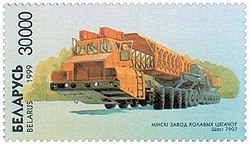MAZ-7907
| MAZ | |
|---|---|
|
MAZ-7907 on a Belarusian postage stamp. The illustration shows the vehicle with a placeholder for the nuclear missile (lattice structure)
|
|
| MAZ-7907 | |
| Manufacturer: | Minsky Avtomobilny Zavod |
| Production period: | 1985 |
| Previous model: | MAZ-7906 |
| Successor: | indirect MZKT-79221 |
| Technical specifications | |
| Designs: | Military vehicle |
| Engines: | Gas turbine |
| Power: | 919 kW |
| Payload: | 150 t |
| Perm. Total weight: | 215.8 t |
The MAZ-7907 ( Russian МАЗ-7907 ) is a heavy truck from the Belarusian vehicle manufacturer Minsky Avtomobilny Zavod , which was designed as a mobile rocket launch pad on an experimental basis . With twelve axles, 28 meters in length and a payload of 150 tons, it was one of the largest trucks in the history of the manufacturer.
Vehicle history
As early as the beginning of the 1980s, various attempts were made at MAZ under the project name Zelina-2 to load the RT-23 intercontinental missile system , which had been supported by rail, onto wheeled vehicles. The problem was relatively obvious: one of the ICBMs weighed 104.5 tons when ready to fire, was 22.6 meters long and 2.4 meters in diameter. In this context, in addition to the MAZ-7907, the slightly smaller MAZ-7906 and the larger MAZ-7904 were designed.
Development of the MAZ-7907 began in March 1983. A first prototype was completed in 1985, a second followed later. The tests ran until 1987, at the end of which the vehicle had covered a distance of just over 2000 kilometers.
With the collapse of the Soviet Union , work on the Zelina-2 project came to a standstill in the 1990s. In 1996 it was finally completely discontinued, the RT-23 missile system was decommissioned by 2005 and finally scrapped by 2008. The two prototypes of the MAZ-7907 were preserved. One was later used again to move a 40-meter-long ship 250 kilometers between two bodies of water.
In 2012, the two prototypes were on the premises of the MZKT plant in Minsk, with one vehicle being used as a spare parts dispenser to keep the second one operational.
The vehicle was designed in such a way that, despite the high overall weight, the best possible off-road mobility was achieved. For this purpose, the 24 wheels were each equipped with their own electric motor. The main unit, a gas turbine of the type GTD1250 with 1250 hp, drove a generator. The turbine actually comes from the T-80 main battle tank . The four front and rear axles can be steered in opposite directions in order to keep the turning circle of the truck within an acceptable range. Even if there was no direct successor for the vehicle, MAZ or the Minski Sawod Koljosnych Tjagatschei (MZKT) later built heavy wheeled tractors like the MZKT-79221 , which also incorporated experience gained from the Zelina-2 project.
Technical specifications
For the MAZ-7907.
- Engine: GTD1250
- Engine type: gas turbine
- Power: 1,250 PS (919 kW)
- Top speed: 25 to 40 km / h
- Axes: 12
- Drive formula : 24 × 24
Dimensions and weights
- Length: 28,187 mm
- Width: 4100 mm
- Height: 4410 mm
- Ground clearance: 465 mm
- Wheel diameter: 1660 mm
- Empty weight: 65,800 kg
- Payload: 150,000 kg
- Total weight: 215,800 kg
Individual evidence
- ↑ On the dimensions of the rockets and photographs of the MAZ-7907 (Russian)
- ↑ a b c d Detailed history of the MAZ-7907 with technical data (Russian)
- ↑ Video and note on the whereabouts on the factory premises, 2012 (English)
- ↑ Online newspaper clipping about the MAZ-7907 and other heavy wheeled haulers from Minsk (Russian) ( Memento from January 3, 2011 in the Internet Archive )

